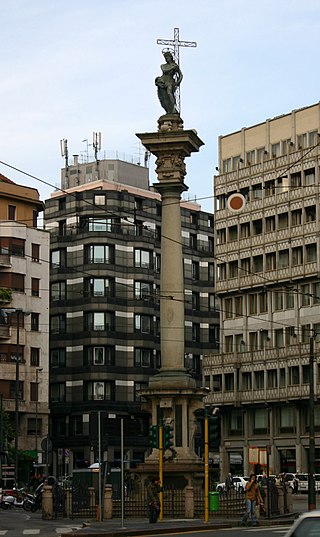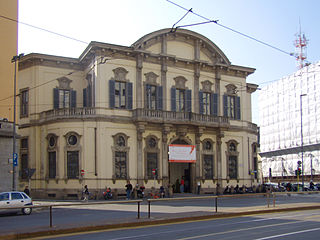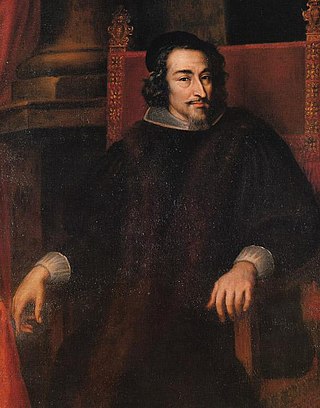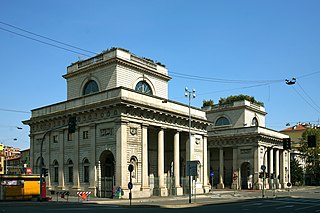History and description
The Palazzo Calchi Taeggi complex dates back to the 16th century. It originally housed the monastery of San Bernardo, until 1506 by Benedictine nuns governed by the Cistercian Fathers of Clairvaux, then by Dominican nuns. [1] A palace rich in history and stories of neglect (including the collapse in 1971 of the church of San Bernardino, of which only 3 arches of the right aisle survive), it links its name to the Calchi family, a noble family from Pavia, and to Giovanni Ambrogio Taegio (d.1553), a Milanese nobleman, who had ordered the foundation of the two respective colleges, later aggregated. [2]
At first it was a convent (in what remains of the monastery courtyard, now the reading garden of the local public library, there are still centenary fig and medlar trees under which one can read and study) and the beautiful 16th-century inner courtyard. It enjoys a privileged history in the Milanese scene and was the scene of many important events It later became an important college where many prominent figures of Catholic culture taught and where Emilio De Marchi also taught two years after graduating in the last century. [3] It was also the scene of the revolutionary uprisings of the Five Days of Milan, where students and professors united together in the name of freedom. [4] Having become a barracks and later a music school, recent agreements have been made between the Municipality of Milan, which will move its Municipal 1 offices there, and the Customs Authority. It is home to a library, a school and various city associations. It hosted during the pandemic the association that took in people living on the streets at night. [5] The building is owned by the public property of the Municipality of Milan; in spring 2022 it has been announced that it is scheduled to be refurbished. [6]

The Certosa di Pavia is a monastery and complex in Lombardy, Northern Italy, situated near a small town of the same name in the Province of Pavia, 8 km (5.0 mi) north of Pavia. Built in 1396–1495, it was once located on the border of a large hunting park belonging to the Visconti family of Milan, of which today only scattered parts remain. It is one of the largest monasteries in Italy.

The Chigi Palace is a palace and former noble residence in Rome which is the seat of the Council of Ministers and the official residence of the Prime Minister of Italy. Since 22 October 2022, the tenant of the Chigi Palace has been Prime Minister Giorgia Meloni, although she doesn't live in the building. It is located in the Piazza Colonna, next to Palazzo Montecitorio, seat of the Chamber of Deputies.

Villas and palaces in Milan are used to indicate public and private buildings in Milan of particular artistic and architectural value. Milan has always been an important centre with regard to the construction of historical villas and palaces, ranging from the Romanesque to the neo-Gothic, from Baroque to Rococo.

Porta Magenta, formerly known as Porta Vercellina, was one of the city gates of Milan, Italy. The gate was established in the 9th century, with the Roman walls of the city; it was moved with the medieval and Spanish walls, and was finally demolished in the 19th century. The phrase "Porta Magenta" is now used to refer to the district ("quartiere") where the gate used to be; the district is part of the Zone 7 administrative division of Milan, west of the city centre.

The Verziere was the traditional greengrocery street market of Milan, Italy. The market itself has been relocated several times, and it is now in Via Lombroso, east of the city centre; the word "Verziere", anyway, still refers to the main historic location of the market, where it was held from 1776 century until 1911. The new greengrocery market of Via Lombroso is more properly referred to as "Ortomercato" or "Mercati Generali".

Palazzo Castiglioni is an Art Nouveau palace of Milan, northern Italy. It was designed by Giuseppe Sommaruga in the Liberty style and built between 1901 and 1903. The rusticated blocks of the basement imitate a natural rocky shape, while the rest of the decorations are inspired by 18th century stuccos. The building is now used as the seat of the Unione Commercianti di Milano.

Casa Panigarola, also known as Palazzo dei Notai, is a historic building of Milan, Italy, located in Piazza Mercanti, former city centre in the Middle Ages. It is named after the House of Panigarola, a family of notaries from Gallarate, that owned the building until 1741. The building thus served as a notary seat, and the activities therein were strictly related to those that occurred in the adjacent Palazzo della Ragione, where trials were held.

The Palazzo delle Scuole Palatine is a historic building of Milan, Italy, located in Piazza Mercanti, the former city centre in the Middle Ages. It served as the seat of the most prestigious higher school of medieval Milan. Many notable Milanese scholars of different ages studied or taught in these schools; Augustine of Hippo and Cesare Beccaria, among others, served as teachers in the Palatine. The current building dates back to 1644, when it replaced an older one, which had the same function and was destroyed by a fire.

The Zone 1 of Milan, since 2016 officially Municipality 1 of Milan, is one of the 9 administrative divisions of Milan, Italy.


Neoclassical architecture in Milan encompasses the main artistic movement from about 1750 to 1850 in this northern Italian city. From the final years of the reign of Maria Theresa of Austria, through the Napoleonic Kingdom of Italy and the European Restoration, Milan was in the forefront of a strong cultural and economic renaissance in which Neoclassicism was the dominant style, creating in Milan some of the most influential works in this style in Italy and across Europe. Notable developments include construction of the Teatro alla Scala, the restyled Royal Palace, and the Brera institutions including the Academy of Fine Arts, the Braidense Library and the Brera Astronomical Observatory. Neoclassicism also led to the development of monumental city gates, new squares and boulevards, as well as public gardens and private mansions. Latterly, two churches, San Tomaso in Terramara and San Carlo al Corso, were completed in Neoclassical style before the period came to an end in the late 1830s.

Bartolomeo III Arese count of Castel Lambro born in Milan on 23 October 1590 and died in the same city on 23 September 1674 was an Italian nobleman, politician, and prominent member of the House of Arese.

The following outline is provided as an overview of and topical guide to Milan:

Eugenio Soncini was an Italian architect.

The Arese are a prominent family of the Milanese nobility.

Palazzo Arese was a 16th century baroque palace and seat of a branch of the House of Arese in Milan, Italy. It was located adjacent to Casa Fontana Silvestri near the Porta Orientale. The palazzo was demolished in 1943 following damage sustained during the bombing of Milan in World War II.

The Casa dei Grifi' is a historic building in Milan, located in Via Valpetrosa 5.

The Palazzo del Monte di Pietà, is a palazzo quattrocentesco in Milano, adapted in forme neoclassiche in the 18th century by Giuseppe Piermarini. Historically belonging to the Sestiere di Porta Nuova, it is located in Via Monte di Pietà no. 5, and was the seat of the Monte di Pietà di Milano.





















